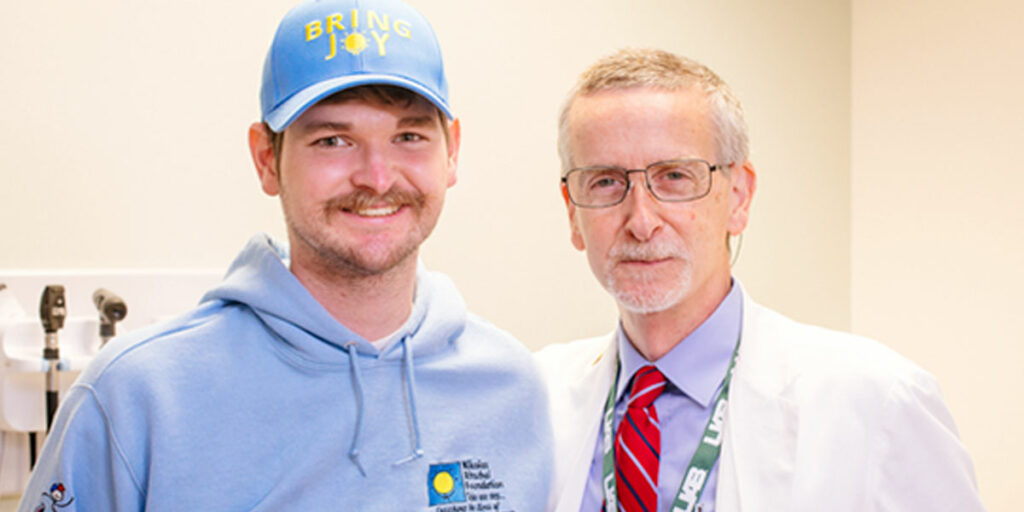In the immediate aftermath of a snakebite, a natural question is “Will I die?”

The answer is, very likely, no, even if the snake is venomous. Only about five people die per year from snakebite in the United States. So, once the initial shock has passed, there is a better question to ask: “Will I be maimed for life?”
“So many people — in the Southeastern United States, especially — have persistent wounds, bad swelling and morbidity issues after snake envenomation, and there was no good place to send them for follow-up,” said Dr. William Rushton, associate professor in the University of Alabama at Birmingham Department of Emergency Medicine in the Marnix E. Heersink School of Medicine.
Rushton is a medical toxicologist and the medical director of the Alabama Poison Information Center, the state’s poison control center, based at Children’s of Alabama. Nearly all snakebites in Alabama trigger a call to APIC. In the heart of snakebite season, Rushton and fellow medical toxicologist Dr. Sukhshant Atti average one or two snakebite consults every day with providers throughout the state.
Nothing like it elsewhere
Last year, Rushton and wound-care expert Dr. Dag Shapshak, associate professor in the Department of Emergency Medicine, launched the first-of-its-kind UAB Comprehensive Snakebite Program, including one of the nation’s first dedicated snakebite follow-up clinics, which treats patients in the hospital, provides follow-up, and studies new approaches and protocols in snakebite. They and their team are pioneering new methods that have resulted in greater peace of mind for patients and doctors alike.
“This is the nation’s very first comprehensive snakebite program,” said Shapshak, who also runs the UAB Comprehensive Wound Care Clinic, where he specializes in treating persistent wounds and swelling. Shapshak’s typical patient in the Comprehensive Wound Care Clinic is about 80 years old and is dealing with complications from diabetes or cancer.
“Our snakebite patients are much younger, from 5 to 30 or so; but the same techniques apply,” Shapshak said. “And they can make the difference between lifelong complications and a full recovery.”
The snakebite clinic provided follow-up treatment after snake envenomation to 17 patients in 2021. That includes a teenage cheerleader with lingering complications and a truck driver with severe envenomation and necrosis that threatened both his job and his ability to play guitar. The UAB Comprehensive Snakebite Program uses lower doses of antivenom and has shorter patient stays than many other hospitals, typically discharging patients in less than 24 hours. Follow-up visits to the snakebite clinic are now offered to any patient whose care triggers a call to APIC, regardless of insurance status.
Deep thinking on snakebites
The UAB Comprehensive Snakebite Program is staffed by toxicologists, wound-care experts, pharmacists and physical therapists. It cares for adults and children as young as 5.
“We will keep seeing people as long as they have persistent wounds and swelling,” Rushton said. “What we’re doing is cutting-edge. No one else is thinking this deeply about snakebites and follow-up.”
“Leaving the hospital after a snake envenomation experience can create a sense of ‘now what?’” Atti said. “Many patients find their questions unanswered, including ‘Do I elevate my limb? Do I do physical therapy? How long will the swelling last?’ and ‘When can I get back to work?’ I believe that having a place to follow up with snake envenomation experts provides comfort to patients that they are not on their own when they leave the hospital.”
The clinic is also reassuring for medical providers, adds Dr. Matthew Kelly, co-medical director for Wound Care and Hyperbaric Medicine at UAB.
“Snakebites are relatively rare, and any one provider may not see too many patients with complications from snakebites,” Kelly said. “With the snakebite clinic, we are able to see patients from throughout the state, and as with many things, experience is key in understanding the nuances of clinical care.”
Bites, blood and avoiding the knife
Snakebites in the United States are rarely fatal. Each year, between 7,000 and 8,000 Americans report being bitten by a snake, and on average, five will die. During Rushton’s seven years in Alabama, there have been very few snakebite deaths, and each of those had relatively unusual circumstances, he says. Snakebite season in Alabama and the Southeast runs from roughly mid-March to mid-November, and most bites occur in the evening.
About 10% of envenomations in Alabama are from rattlesnakes. The rest are from other pit vipers, including copperheads, cottonmouths and water moccasins. Doctors are quick to distinguish envenomation from the more all-encompassing term snakebite, because up to 50% of bites are dry, with no venom injected.
The most common complications from envenomation are local wound damage, swelling of extremities and severely painful blood blisters. When a snake envenomates a person, often on the foot, the tissues fill up with blood.
“For someone with little experience of snakebite, that swollen leg can look like dead, necrotic tissue that needs to be removed to avoid wider damage,” Rushton said. “That’s a hallmark of our program: to keep people away from unnecessary or harmful procedures. These large blood blisters are cared for by a wound-care specialist who has specific training of the mechanisms of envenomation. What we don’t want is someone trying to cut away that tissue, at least early on during active envenomation.”
Comprehensive, multidisciplinary snakebite care
The program’s multidisciplinary approach is what truly sets it apart, Rushton says. While patients are in the hospital, physical therapists emphasize early range-of-motion exercises and getting patients out of bed. Rushton says UAB pharmacy expertise has been crucial with the timing of the antivenom. Patients then get follow-up in the snakebite clinic and the benefit of the program’s research efforts.
The Comprehensive Snakebite Program is an innovator in the use of thromboelastography, or TEG, a method of precisely studying blood coagulation, clot strength and clot stability. TEG can provide a more rapid answer than traditional tests, such as prothrombin time and partial thromboplastin time tests. Because the Department of Emergency Medicine is a national leader in research, access to TEG is widespread enough that every snakebite patient admitted to UAB can receive the benefit of this technology, Rushton notes.
Even though rattlesnakes make up less than 10% of envenomation in the Southeast, rattlesnake bites can cause life-threatening coagulopathy.
“We don’t want to miss those,” Rushton said. “The reason we get TEGs on every snakebite patient is to screen for rattlesnake bites that may have been erroneously reported as copperhead bites. If that is the case, we will be more aggressive about giving antivenom. TEG can also be used to more precisely measure the antivenom dose, for the benefit of the patient, Rushton said.
Although the evidence is still out on whether TEGs are better than traditional labs, Rushton says the team can predict rattlesnake bites on the thromboelastogram earlier than from traditional coagulation markers.
“Snakebites can be intimidating to treat given all of the various scenarios in which patients can present,” Atti said. “Many community hospitals in the state of Alabama don’t have enough antivenom for more than one loading dose nor the means to care for a critically ill patient from a snake envenomation. This can create a lot of uncertainty for a community physician in trying to decide whether a patient needs to be transferred to another hospital for further care. We’re able to guide physicians in such scenarios, allowing them to make sound decisions.”
This story originally appeared on the UAB News website.
(Courtesy of Alabama NewsCenter)
















